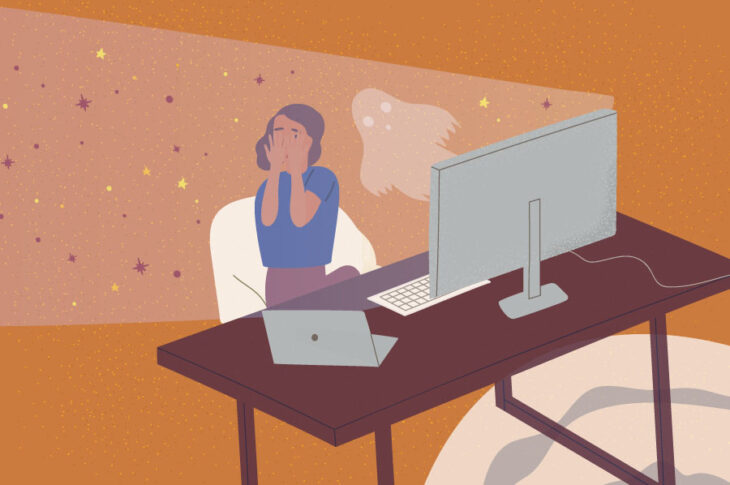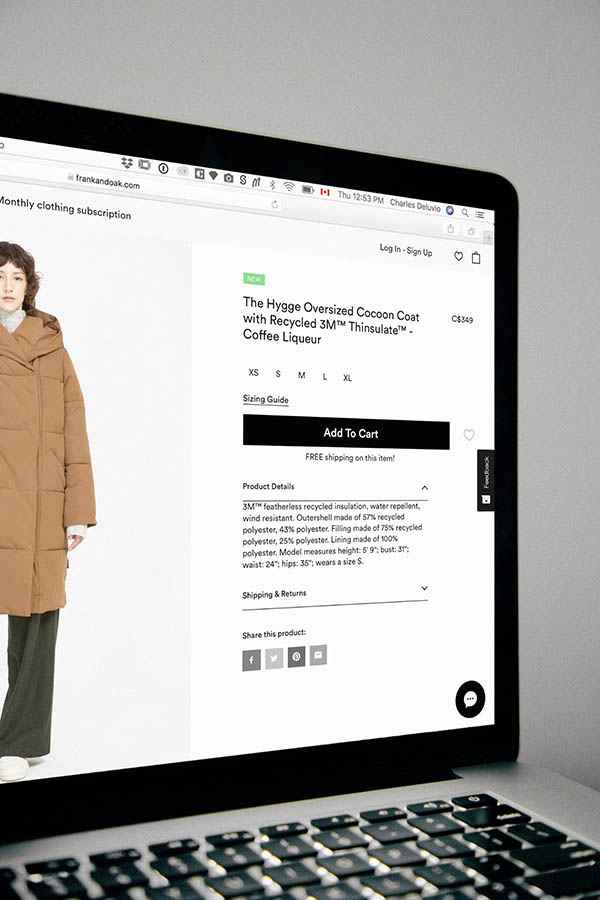7 Web Design Mistakes That Could Be Scaring Away Your Visitors

What is keeping internet users up at night? It could be that scary movie they just watched, or worse yet, it could be your website.
If you’ve got a digital presence decked out in a ghastly design, it’s likely robbing you of precious clicks, driving away potential customers, and sabotaging your chances of building a well-ranking, authoritative brand.
The good news? You don’t need to be a web designer or an expert in web development to improve a weak website!
In this guide, we’ll detail seven scary web design mistakes that could be spooking your visitors — and how to fix them quickly — so you can make sure your website is all treats and no tricks.
Get a Beautiful Website You’re Proud Of
Our designers will create a gorgeous website from scratch to perfectly match your brand.

1. Scary Slow Site Speeds
For consumers browsing the internet, nothing is more spine-chilling than a slow-loading site. Before you can say “Boo!” they’ve abandoned your page, leaving you with irritated audiences and suffering engagement.
In fact, page speed can be the make-it-or-break-it factor for the success (or failure) of your website, dramatically affecting everything from sales to sign-ups to search traffic.
Visitors have high expectations: 47% of consumers expect a web page to load in two seconds or less, and 49% abandon a site that takes more than three seconds to load. Plus, 79% of online shoppers who have trouble with site performance say they won’t return to the site to buy again.
Ouch. That’s a lot riding on your site’s load time and overall performance.
Is your site (creepy) crawling? Use a tool like Google’s PageSpeed Insights to clue into your site’s performance and discover needed areas of improvement to achieve lightning-fast load times.

We’ve also got a few tips to speed things up: trim down bulky code, patch up caching issues, optimize your site’s CSS, and perhaps most importantly, choose a quality web host.
2. A Haunting User Experience
Now let’s take a trip in the way-back time machine, you know, before COVID-19 changed everything.
Think about the last experience you had at a brick-and-mortar store. Did the floor layout, decor, and atmosphere invite and engage you? Or did tight aisles, overly-intrusive sensory elements, or labyrinth-like setup negatively affect your shopping experience? Whatever your experience, we’ll take a guess that it largely determined whether or not you wanted to visit that store again.
It’s the same with your website.
The kind of experience users have on your site (from the second they land there) will affect how — and if — they engage with you. If your site contains nightmare navigation, unsavory design elements, or poor performance, visitors won’t stay long.

To craft and cultivate a positive user experience, make your navigation and drop-down menu intuitive so users can find what they’re looking for. Then follow aesthetically-pleasing design principles and keep site operations fine-tuned. If your visitors have an enjoyable experience on your site, not only will they be more likely to come back, they’ll engage with you and help you find site success.
Related: How to Build an Awesome Online Store with the OceanWP Theme
3. An Unresponsive Layout
Ready for some hair-raising facts? Based on data from January 2018, the global population of unique mobile device users reached 3.7 billion — yep, billion. What’s more, 52% of web internet traffic in 2018 was mobile, and the mobile-only audience is expected to grow to 55 million by 2022.
Mobile internet usage is gaining significant traction, and will likely overtake desktop internet usage in the future. That means if your website is not optimized for different types of screens, including smartphones and tablets, you’re going to lose out on meaningful engagement from your target audiences.
Related: How to Optimize Your Website for Mobile Devices
Plus, having a responsive site isn’t just important for user experience; it’s a critical element of your SEO strategy. Google operates on a mobile-first indexing policy, meaning the search engine predominantly uses the mobile version of website content for indexing and ranking. So, investing in a mobile-first approach to your web design is essential when it comes to optimizing for search engines and, ultimately, driving traffic to your site.

Responsive design also affects your brand image. A whopping 89% of people are likely to recommend a brand after a positive experience on mobile. On the other hand, 46% of people say they would not buy from a brand again if they had a less-than-stellar mobile experience. What’s more, 57% of users say they won’t recommend a business with a poorly-designed mobile site.
The key takeaway here?
Prioritize a website optimized for mobile and responsive across devices and different browsers.
Related: What Makes a Good Website?
4. Terrifying Typography
You might not think the fonts on your site matter, but utilizing type haphazardly or without thoughtful intention is a major design flaw and affects the experience your visitors will have, even if just subconsciously.
Just like with other elements of design, typography follows rules — dictating what text combinations, colors, font size, and layouts are aesthetically-pleasing and effective. Well-established typography can increase your conversion rates, build your brand authority, encourage action, amplify your message, and create a positive sensory experience.
Consult our guide for typography to-dos, and plan your font strategy with meticulous consideration or else you risk interrupting usability and cognitive fluency.
Related: How to Build a Lead-Generating Landing Page with WordPress (3 Steps)
5. Ghostly Calls to Action
When you enter a haunted house, you never quite know what you’re going to get. Zombie up ahead? Hidden skeletons behind the door? Unidentified noises behind you? As you’re feeling for the exit in the dark, you’re going to face a host of unexpected and spooky mysteries.
Your website visitors shouldn’t feel like they’re having a haunted house experience when they type your URL.
When internet users land on your site, it should be free of mystery ghosts and ghouls. Meaning, visitors should know what to expect. They should know where to find a contact button, how to navigate your menu, and above all, what you want them to do — whether that’s read a blog post, subscribe to an email list, follow your social media platforms, or purchase a specific product.

Having a clear call-to-action button helps users know how to engage with you, vastly increasing the chances you’ll find success (and those boosted analytics you want!). Guide potential customers to a specific action with a clear, prominent, and well-distinguished icon or button and include it on all your pages and content.
Related: 7 Tips for Writing Winning Calls to Action for Your Website
6. Spine-Chilling Safety Oversights
Online users worry (a lot) about online safety. In fact, 73% of Americans who use the web are concerned about online privacy, so your website needs to be a safe space, free from creepy-crawly web demons and malicious malware.

First, outfit your site with an SSL certificate, giving your visitors the peace of mind that your website is secure. Even the presence of a safety badge or security can do wonders.
Then, tighten security by using a quality web host, upgrading to HTTPS, utilizing secure plugins, configuring file permissions, and backing up your site regularly to keep site terrors at bay.
Related: How to Back up Your WordPress Website — A Complete Guide
7. Cloak–and–Dagger Content
The fact of the matter is, you need to offer your website visitors value or else they have no reason to stay.
With quality content, you provide users with a way to engage with you, helping drive traffic and build a following. But if your content is hard to find, sub-par, or (gasp!) nonexistent, you’re sabotaging your chances of success. Use the following tips to make sure you’re creating top-notch content.
Embrace Your Niche
Whatever field or industry you occupy, keep your content consistent for your target audience. Relevant content will build your brand and help establish your site as an authority amongst your competition, distinguishing you from the rest.
Proofread
Error-ridden content will brand you as an amateur. Stay professional by taking the time to edit and polish your content before hitting “Submit.” Clean content will go a long way toward establishing your brand.
Related: How to Create a Brand Style Guide for Your Website
Offer Value
Not only are attention spans shorter than ever, but often, visitors need a good reason to even engage with your site. Entice potential customers with incentives — whether that be free e-books, blog posts, printables, or insider tips — to get their eyes on your content.

You don’t have to post content on your site every hour, but you should be posting regularly. Your visitors should know when to expect new content from you. This will build their trust — and your authority. Use a content calendar to plan, schedule posts ahead of time, and keep yourself organized. If you want a few pointers, check out our guide to creating a content marketing strategy.
Get Content Delivered Straight to Your Inbox
Subscribe to our blog and receive great content just like this delivered straight to your inbox.
Fix Those Eerie Web Design Errors
Don’t give your audiences the heebie-jeebies with poor website design. Offer them the best of online experiences with the virtual treat (we’re talking king-size candy bars here) of a well-designed website.
Fixing those pesky web design mistakes will prime you for top-of-the-line placement in search engines, improve user experience, boost conversions, enhance site usability, lower your site’s bounce rate, and establish your online presence — plus, they won’t leave screaming.
Sounds good, right?
If you’re ready to makeover your website, trick-or-treat yo’ self to a professional web design. Our talented designers can create a polished, professional website (and brand) to reflect your vision at an affordable price. Learn more about our professional design services today!